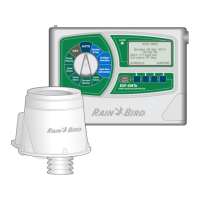ESP-SMT Smart Modular Control System
75
Soil Classification Triangle
This tool is used to classify the soil based on soil texture.
Soil texture describes the size and shape of individual
soil particles such as sand, silt, or clay. The soil texture
class describes the relative amounts of sand, silt, and
clay in that particular soil.
Soil texture has a major inuence on the amount of
water stored (moisture holding capacity) in a soil. This is
used to determine how much to irrigate and the timing
of required irrigation.
The ability of water to enter the soil prole (inltration
rate) and the rate at which water can move through the
soil (permeability) is determined by the soil texture. The
inltration rate and permeability of the soil, combined
with the slope of the irrigated area will determine how
long each irrigation event (cycle) should run and how
much time should elapse (soak) between cycles to
prevent water from running o the soil.
To determine the Soil Type (Classication) using the Soil
Classication Triangle, draw a parallel line for the value
of each soil particle type. The Soil Type is identied by
where the three lines intersect in the Soil Classication
Triangle.
The three soil particle type lines for the soil sample
example intersect in the LOAM soil classification area.
90
100
80
70
60
50
40
30
20
10
0
100
90
80
70
60
50
40
30
20
0
10
0
10
20
30
40
50
60
70
80
100
90
SAND
CLAY
LOAM
SANDY
LOAM
SILTY
CLAY
CLAY
PERCENT
CLAY
PERCENT SAND
PERCENT
SILT
LOAM
LOAMY
SAND
17%
66%
17%

